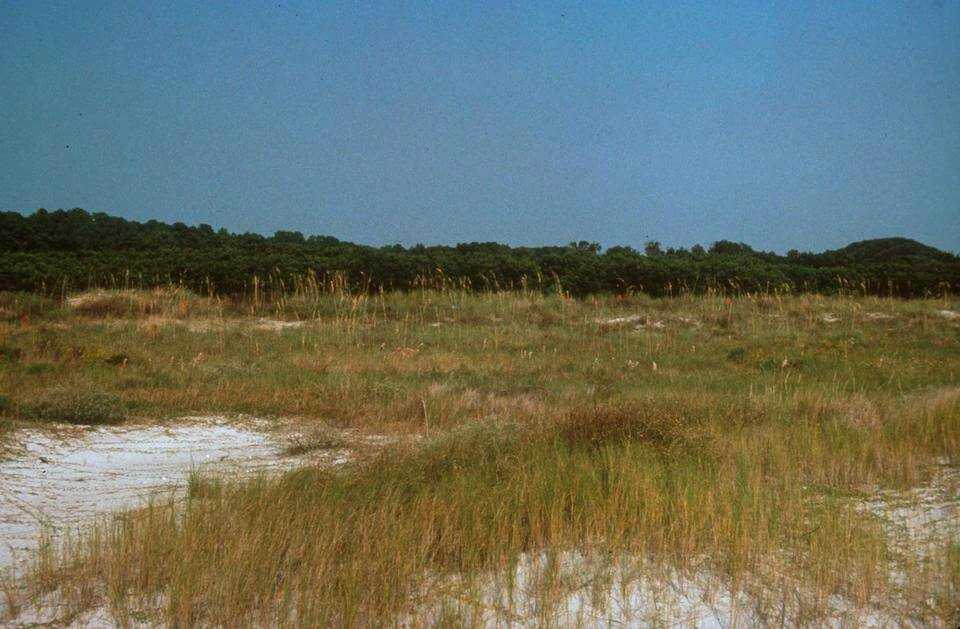- Coastal Grassland
Coastal Grassland
within Coastal Uplands
Vulnerability:
General Information
Coastal grasslands are characterized as treeless flatlands with barren sand or a sparse to dense ground cover of grasses, prostrate vines, and other herbaceous species that are adapted to harsh maritime conditions. The coastal grassland community generally occurs as one of two types; on newer sand deposits, typically composed of a variety of tall grasses (Muhly grass, Saltmeadow cordgrass, Bushy bluestem, Tall threeawn, plus occasional remnant patches of sea oats) or on older, more stable portions of the broad barrier islands consisting of short, dense stands of hairy grama grass.
Area
- 1,151 hectares within Florida (modeled)
- 1,065 hectares (93%) is located on public lands
Area impacted by up to 3 meters sea level rise:
Climate Impacts
Coastal grassland habitat is likely to have 63% of the current area inundated by 1 m of sea level rise and 96% inundated by 3 m of sea level rise. Inundation and impacts from storm events will lead to increased fragmentation and changes in the structure (geomorphology) of the system. Increased soil salinity will lead to changes in species composition as salt intolerant plants decline and plants with higher salt tolerances increase.
Increased temperatures, as well as extreme events will enhance invasive species processes, from introduction through establishment and expansion.
More information about general climate impacts to habitats in Florida.
Climate Impacts to Species
Beach mice will be impacted by habitat degradation as dune plant species composition changes (potential loss of food plants), habitat fragmentation as dunes become more disjunct from one another due to inundation, and habitat loss from inundation.
Gopher tortoises utilize areas of coastal grasslands and will be impacted as these grasslands become inundated due to sea level rise.
More information about general climate impacts to species in Florida.
Other Non-climate Threats
- Coastal development
- Conversion to housing and urban development
- Conversion to recreation areas
- Disruption of longshore transport of sediments
- Incompatible fire
- Incompatible recreational activities
- Industrial spills
- Invasive animals
- Invasive plants
- Roads, bridges and causeways
- Shoreline hardening
More information about climate change interactions with existing threats and stressors in Florida.
Vulnerability Assessment Details
This habitat was assessed as part of the Standardized Index of Vulnerability and Value Assessment - Natural Communities (SIVVA).
This habitat has a SIVVA vulnerability score greater than 70 but is not among the top 5 most vulnerable natural communities in any SIVVA vulnerability category.
Read more information about SIVVA natural communities.
This habitat was assessed in combination with Beach Dune.
Adaptation Strategies
Protection
- Protect potential refugia, corridors, and relocation sites.
- Protect coastal vegetation to reduce the impact of increased disturbance events (intense storms, increased erosion) and encourage aeolian sand capture.
- Create setbacks or rolling easements.
- Develop conservation easements to protect climate-vulnerable areas.
- Preserve undeveloped and vulnerable shoreline.
- Identify and protect locations where native species may shift or lose habitat due to climate change impacts.
- Maintain corridors and linkages between undeveloped areas.
Restoration
- Restore coastal vegetation to improve habitat for species that require early successional habitat.
- Restore and/or protect coastal vegetation to reduce the impact of increased disturbance events (intense storms, increased erosion) and encourage aeolian sand capture
- Develop corridors and linkages between undeveloped areas.
- Reduce impacts from points of access (e.g., paths, boardwalks).
- Remove invasive plants and prevent new species from becoming established.
- Restore native plant communities, using stock that is more likely to persist in future climatic conditions.
- Redesign or mitigate existing physical barriers or structures that impede movement and dispersal within and among habitats.
Planning
- Coordinate with County staff to incorporate sea level rise adaptation strategies into comprehensive plans and post-storm redevelopment activities
- Identify areas particularly vulnerable to loss or transition under climate change and develop management strategies and approaches for adaptation.
- Modify conservation management priorities to include species and habitat adaptation to the effects of climate change.
- Incorporate altered or restricted points of access into plans to accommodate impacts from climate change.
Policy
- Consider restrictions on other human activities (e.g., mechanical beach cleaning, armoring) that pose a threat to species through disturbance and/or habitat degradation
- Restrict development and other land uses that alter disturbance processes in sensitive areas
- Identify overused areas and limit recreational trails/roads and OHV use.
- Centralize recreation impacts to easy-access areas.
- Provide greater regulation and enforcement of recreational use and access restrictions.
- Zone development away from sensitive and hazard-prone areas.
- Institute or strengthen building codes in flood- and erosion-prone areas to reduce erosion.
Education and Outreach
- Educate landowners and planners on benefits of structural walkways over vegetation rather than pedestrian pathways through vegetation/dunes.
- Educate planners on the importance of healthy resilient coastal systems to protect against coastal hazards.
- Work with communities and landowners to choose native vegetation in favor of non-native vegetation.
- Work with communities and landowners to choose vegetation, living shorelines, oyster reef restoration, or hybrid approaches in favor of traditional hard armoring.
- Promote “keeping cats indoors” to protect beach nesting activities .
